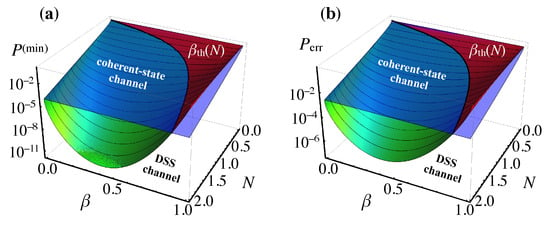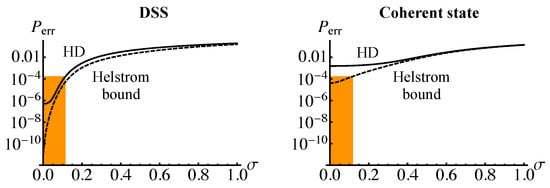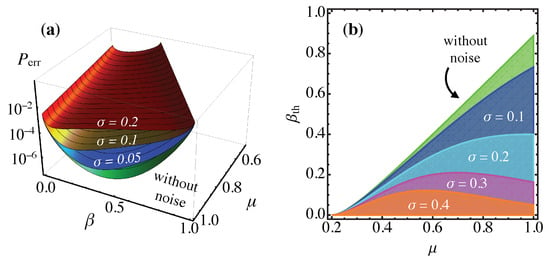Abstract
We address the use of squeezing in binary phase-shift-keyed (PSK) channels at fixed energy. In particular, we assess homodyne receivers against the Helstrom bound in the presence of phase noise. We also take into account possible imperfections in the generation of squeezing and the effect of losses during propagation. We find that squeezing is a useful resource if its amplitude is below a given threshold depending on the energy of the signals and on the properties of the channel. Squeezing enhancement is present also when phase-noise becomes large.
Quantum discrimination of nonorthogonal signals has been largely investigated from a fundamental point of view [1,2,3] and it is now a primary tool for the implementation of quantum communication protocols [4,5]. In the continuous-variable regime, coherent states are largely employed, but recently also squeezed states have attracted much interest [6,7]. Concerning the detection stage, the search for optimal receivers, i.e., detection schemes able to discriminate between two signals at the Helstrom bound [3], has eventually led to the Kennedy and Dolinar receivers, which are essentially based on the interference of the signal with a reference state. In turn, the performances of those detection schemes are drastically degraded by phase fluctuations. On the other hand, it has been shown that in the presence of phase noise, a receiver based on homodyne detection allows one to approach optimality in the discrimination of coherent signals [8]. In this paper, we investigate whether, and to which extent, squeezing may help in binary discrimination when phase noise and losses affect the signals [9]. More in details, we address a binary communication channel in which the two states to be discriminated are displaced-squeezed states (DSSs), discuss the Helstrom bound for two DSSs and compare the results with those obtained with coherent states and homodyne detection in ideal conditions. Then we investigate the effect of phase noise on the discrimination. Finally, we analyze the effect of losses, which modify the purity of the signals.
In PSK coherent-state communication, one should discriminate between the two symbols , , where is the displacement operator, and the assumption holds without lack of generality. In our analysis, we require that the binary information is encoded exploiting DSSs, i.e., , , where is the squeezed vacuum, being the squeezing operator. Moreover, we assume without lack of generality the squeezing parameter . In the following, as a figure of merit we consider the discrimination error probability as a function of the total energy N and of the squeezing fraction , where is the number of squeezed photons. Given the two states , , the minimum error probability is given by the Helstrom bound , assuming equal prior for the two signals [3]. As shown in Figure 1a, where we plot for the DSSs and coherent states as a function of N and , it is possible to find a threshold value of the squeezing fraction such that the error probability for a pair of DSSs is smaller than the corresponding coherent case [6,9]. The minimum of is instead achieved for . For a homodyne receiver, one still finds the same threshold for the corresponding homodyne-detection error probability (see [9] for the details about the calculation of the corresponding ). However, the scalings of and are different, as shown in Figure 1b. In the presence of phase noise, the state is substituted by the density operator [8]

Figure 1.
(a) The Helstrom bound for DSSs as function of the squeezing fraction and the channel energy N. The plane corresponds to the Helstrom bound for coherent states and the solid line to the threshold . (b) The homodyne-detection error probability as a function of for different values of the channel energy N. The plane corresponds to the minimum error probability achievable using only coherent states and homodyne detection and the solid line to the threshold . Figures adapted from [9].
In this scenario, the performance of the homodyne receiver with DSSs approaches optimality, leading to the corresponding Helstrom bound, now given by the more general relation . This is shown, for a particular choice of the parameters, in Figure 2, where the homodyne-detection error probabilities for DSSs and for coherent states are plotted as a function of the noise parameter . We remark that DSSs allow to get a smaller error probability and also to beat the Helstrom bound of the coherent-state case for small values of .

Figure 2.
Comparison between the error probability (solid lines) and the Helstrom bound (dashed lines) as functions of the noise parameter for the DSS and the coherent state. We set and . The shaded region refers to the range of the noise parameter values such that the homodyne probability with DSS is below the Helstrom bound with coherent states. Figures adapted from [9].
Losses during the propagation of the signal through the channel or imperfection in the generation of the seed squeezed state can be summarized by replacing the squeezed vacuum with the more general squeezed thermal state , where is a “thermal state” with average number of photons given by , being the purity of the state [9]. In the Figure 3a we show the error probability for (analogous results can be found for other energies). As one may expect, the presence of a mixed seed state ( < 1) increases the error probability; nevertheless, we can still find a threshold of the squeezing fraction below which squeezing improves the discrimination with respect to the coherent state (for the same fixed energy). The threshold now depends also on the purity of the state, as shown in the Figure 3b.

Figure 3.
(a) Error probability of the homodyne receiver as a function of and the purity for different values of the noise parameter . (b) Threshold value of the squeezing fraction as a function of the purity for different values of . The shaded regions refer to the pairs of parameters for which DSSs outperform coherent states. Note that . In both the panels we set . Figures adapted from [9].
The obtained results put forward squeezing as a resource for quantum discrimination in the presence of phase noise and losses. In particular, two critical values for the squeezing fraction can be always identified: a threshold value , below which squeezing helps, and an optimum value , which minimizes the error probability (at fixed total energy) [9]. The two quantities depend on the total energy of the signals and on the parameters characterizing the channel. Moreover, our analysis has also shown that, when information is encoded on DSSs, the homodyne revceiver approaches optimality in the presence of phase noise and, remarkably, can also overcome the Helstrom bound obtained in the case of coherent state encoding.
Author Contributions
All the authors contributed equally to this work.
References
- Yuen, H.P.; Kennedy, R.S.; Lax, M. Optimum testing of multiple hypotheses in quantum detection theory. IEEE Trans. Inf. Theory 1975, 21, 125–134. [Google Scholar] [CrossRef]
- Bergou, J.A. Discrimination of quantum states. J. Mod. Opt. 2010, 57, 160–180. [Google Scholar] [CrossRef]
- Helstrom, C.W. Quantum Detection and Estimation Theory; Academic Press: New York, NY, USA, 1976. [Google Scholar]
- Günthner, K.; Khan, I.; Elser, D.; Stiller, B.; Bayraktar, Ö.; Müller, C.R.; Saucke, K.; Tröndle, D.; Heine, F.; Seel, S.; et al. Quantum-limited measurements of optical signals from a geostationary satellite. Optica 2017, 4, 611–616. [Google Scholar] [CrossRef]
- Diamanti, E.; Lo, H.-K.; Qi, B.; Yuan, Z. Practical challenges in quantum key distribution. NPJ Quantum Inf. 2016, 2, 1–6. [Google Scholar] [CrossRef]
- Shapiro, J.H.; Yuen, H.P.; Mata, J.A.M. Optical Communication with Two-Photon Coherent States—Part II: Photoemissive Detection and Structured Receiver Performance. IEEE Trans. Inf. Theory 1979, IT-25, 179–192. [Google Scholar] [CrossRef]
- Nair, R.; Yen, B.J.; Guha, S.; Shapiro, J.H.; Pirandola, S. Symmetric M-ary phase discrimination using quantum-optical probe states. Phys. Rev. A 2012, 86, 1–12. [Google Scholar] [CrossRef]
- Olivares, S.; Cialdi, S.; Castelli, F.; Paris, M.G.A. Homodyne detection as a near-optimum receiver for phase-shift-keyed binary communication in the presence of phase diffusion. Phys. Rev. A 2013, 87, 1–4. [Google Scholar] [CrossRef]
- Chesi, G.; Olivares, S.; Paris, M.G.A. Squeezing-enhanced phase-shift-keyed binary communication in noisy channels. Phys. Rev. A 2018, 97, 1–6. [Google Scholar] [CrossRef]
© 2019 by the authors. Licensee MDPI, Basel, Switzerland. This article is an open access article distributed under the terms and conditions of the Creative Commons Attribution (CC BY) license (http://creativecommons.org/licenses/by/4.0/).